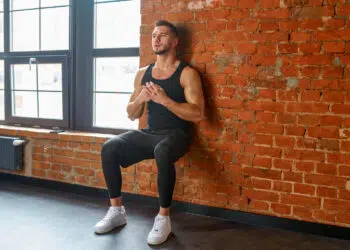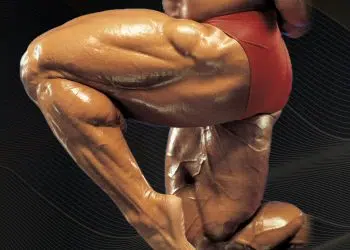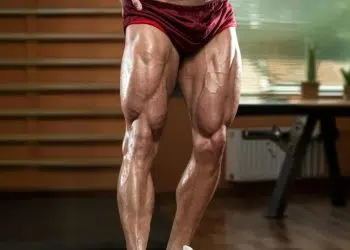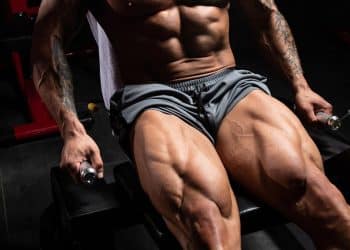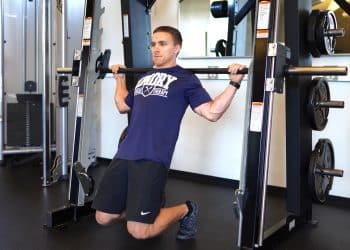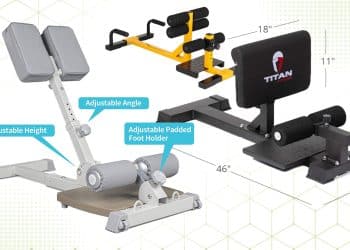When it comes to quads isolation exercises, your options are pretty limited. In fact, your only real option is leg extensions. And while there is nothing wrong with making leg extensions a cornerstone of your lower-body workouts, do them often enough, and they’ll eventually start to lose their potency.
You can do leg extensions in several different ways to ward off boredom. For example, you can do single-leg extensions, leg extension 21s, leg extension iso-holds, paused-rep leg extensions, and leg extension drop sets. But, the movement remains largely unchanged.
Yes, squats, lunges, and leg presses hit your quads, too, but only leg extensions allow you to train your quads without also working your glutes and hamstrings.
The good news is that there IS another exercise you can do to isolate your quads, and you don’t need a leg extensions machine to do it. That exercise is Reverse Nordic Curls, aka Reverse Nordics or Bodyweight Leg Extensions.
In this article, we reveal why and how to do this challenging bodyweight quads exercise.
Reverse Nordic Curls – Muscles Worked
Reverse Nordic curls are an isolation exercise, which means movement occurs at only one joint, and it involves relatively few muscles.
Level Up Your Fitness: Join our 💪 strong community in Fitness Volt Newsletter. Get daily inspiration, expert-backed workouts, nutrition tips, the latest in strength sports, and the support you need to reach your goals. Subscribe for free!
The main muscles trained by reverse Nordic curls are:
Quadriceps
Located on the front of your thighs, the quadriceps are a group of four muscles with separate origin points and a shared insertion. The four quadriceps muscles are rectus femoris, vastus lateralis, vastus medialis, and vastus intermedius. The four quadriceps work together to extend your knee joint, and the rectus femoris also aids in hip flexion.
Hip flexors
Working with the rectus femoris, the hip flexors lift your leg forward in a movement called hip flexion. If only all muscle names were so straightforward and logical! The main muscles in the hip flexors are the psoas major and iliacus. These muscles are so closely related that they’re often collectively known as the iliopsoas.
While the hip flexors are involved in reverse Nordic curls, they mostly work isometrically or statically to hold your hips in the correct position.
Core
Core is the collective name for the muscles of your midsection, including the rectus abdominis, obliques, transverse abdominis, and erector spinae. These muscles work together to generate intra-abdominal pressure, which supports your spine and prevents unwanted movement. Leaning back during reverse Nordic curls means the core has a lot of work to do during this exercise.
How to Do Reverse Nordic Curls
Get more from reverse Nordic curls while keeping your risk of injury to a minimum by following these guidelines:
- Kneel down so your body is upright and your knees, hips, and shoulders form a straight line. Press the tops of your feet into the floor. Your knees should be about hip-width apart.
- Cross your arms over your chest, brace your core, and engage your glutes.
- Keeping your body straight and only moving your knees, lean back as far as you are able.
- Push your feet into the floor to return to the upright position.
- Continue for the desired number of reps.
Tips:
- Kneel on a folded gym mat or foam pad for comfort.
- Lean back as far as you can without losing neutral spine or bending at the hips.
- Descend slowly and then come up a little quicker to maximize quadriceps engagement.
- Hold a weight plate across your chest to make this exercise more demanding.
- Attach a resistance band to an anchor in front of you and use it for assistance if reverse Nordic curls are too challenging, like this:
Read also: Nordic Ham Curl Exercise Guide
Reverse Nordic Curl Benefits and Drawbacks
Not sure if reverse Nordic curls are the right exercise for you? Consider these advantages and benefits and then decide!
- Convenience – you can do reverse Nordic curls almost anywhere and anytime. Because you don’t need a leg extension machine to do them, this is one of the few quads isolation exercises you can do at home. Also, because you only need a mat and your body weight to do reverse Nordic curls, set-up time is minimal, so they’re ideal for workouts like circuit training, supersets, and high-intensity interval training.
- Range of motion – reverse Nordics load your quads in a very stretched position. This is especially true for the rectus femoris. This is one of the few leg exercises to do this. The unusual range of motion means reverse Nordic curls work your quads in a very unique way, which could help trigger renewed muscle growth. In studies, reverse Nordic curls have been shown to have a positive effect on muscle strength and hypertrophy (1).
- Improved flexibility – the reverse Nordic curl is part quads strengthening and part quads stretching exercise. If you want to build your quads and improve your flexibility, the reverse Nordic curl can help.
- Scalable – you can make reverse Nordic curls as hard or as easy as you wish. The further you lean back, the more challenging this exercise becomes. You can also use weights to make it harder or a resistance band to make it easier. As such, reverse Nordic curls are suitable for beginner, intermediate, and advanced exercisers.
While reverse Nordic curls are a mostly beneficial exercise, there are also a few drawbacks to consider:
- Knee strain and pain – some exercisers may find that reverse Nordic curls cause knee pain. This is especially true for people with pre-existing knee conditions. Doing too much too soon may also cause knee pain. Avoid problems by increasing the range of motion and your training volume gradually. Stretching the quadriceps may also help.
- Minimal load on the quads at the top of each rep – there is very little tension on the quadriceps when your thighs are vertical. However, there is a lot of stress at the midpoint of each rep. This means there is an opportunity to rest between reps. One way around this is to contract your quads as hard as possible at the top of each rep. This ensures the target muscles remain under tension for longer.
10 Reverse Nordic Curl Variations and Alternatives
Reverse Nordic curls are a highly effective bodyweight quadriceps exercise, but that doesn’t mean you need to do them all the time. There are plenty of variations and alternatives you can use to keep your workouts productive and interesting:
1. Sissy squat
The sissy squat is an old-school quads exercise that will add slabs of muscle to your quadriceps. Like reverse Nordics, it provides your quads with a deep stretch at the bottom of each rep. And don’t let the name fool you; this is a demanding quad-building exercise.
Steps:
- Stand next to a wall or some other object you can use for balance.
- Rise up onto your tiptoes.
- Push your hips and knees forward and squat down as you simultaneously lean back. Descend as far as you can, ideally until your shins are roughly parallel to the floor.
- Drive your toes into the floor and stand back up.
- Tense your quads and glutes at the top of each rep and repeat.
Muscles targeted:
- Primary: Quadriceps.
- Secondary: Hip flexors, core.
Benefits:
- No equipment required.
- An excellent alternative to leg extensions and reverse Nordic curls.
- Easy to load using a weighted vest or holding a weight vest on your chest.
Tips:
- If flexibility allows, descend until your knees lightly touch the floor.
- Drive your knees forward beyond your toes to maximize quads engagement.
- Push your hips forward to emphasize the rectus femoris muscle.
- The more you lean back, the more challenging this exercise becomes.
Read also: Best Sissy Squat Alternatives
2. Heels elevated goblet squat (aka cyclist squat)
While there is no denying that this is a compound exercise, it’s also very quad-centric. In fact, the only muscles you’ll probably feel working are your quads. Raising your heels pushes your knees forward and puts your body in a very upright position. This reduces hamstring and glute activation for a more challenging quads workout.
Steps:
- Place two bumper weight plates on the floor about hip-width apart. Alternatively, use a length of wooden plank. Stand with your heels raised and the balls of your feet on the floor.
- Hold a kettlebell in front of your chest and just below your chin. Pull your shoulders down and back, and brace your core. Look straight ahead.
- Keeping your torso upright, bend your knees, and squat as deeply as you can without rounding your lower back.
- Stand up, stopping just short of locking your knees to keep the tension on your quads.
- Descend again and repeat for the required number of repetitions.
Muscles targeted:
- Primary: Quadriceps.
- Secondary: Hamstrings, gluteus maximus, core.
Benefits:
- A very quads-centric compound leg exercise.
- No squat rack required.
- A very safe exercise; drop the weight in front of you if you cannot complete a rep.
Tips:
- Do this exercise with a dumbbell if you don’t have access to kettlebells.
- Vary the height of your heel raise to see what works best for you.
- Drive your knees forward and over your toes to target your quads more. Contrary to popular opinion, squats with your knees in front of your toes are NOT bad for your joints, providing you have no pre-existing knee problems.
3. Barbell hack squat
The barbell hack squat was a favorite quads builder of old-time strongman and wrestler George Hackenschmidt, who was famed for his massive legs. While most people tend to do machine hack squats nowadays, the barbell version is still a very effective exercise.
Steps:
- Stand with your back to the barbell, with your legs slightly wider than shoulder-width apart, toes pointed slightly outward.
- Squat down and grab the barbell with a wider than shoulder-width grip.
- Keep your back straight, chest up, and core tight.
- Drive your feet into the floor and stand up, pulling the barbell up against the back of your legs.
- Bend your knees and lower the barbell to the ground.
- Repeat for the desired number of reps.
Muscles targeted:
- Primary: Quadriceps.
- Secondary: Hamstrings, gluteus maximus, core.
Benefits:
- A low-tech alternative to machine hack squats.
- A very safe exercise – no spotters or squat rack required.
- This exercise uses a large range of motion, which is good for developing mobility and flexibility.
Tips:
- Place your heels on raised blocks to increase quads engagement.
- Use a trap bar instead of a barbell for a more comfortable workout.
- Push your knees forward beyond your toes to increase quads engagement.
4. Hack squat machine
Most gyms have a hack squat machine. While this IS a compound exercise, it’s also very quad-centric, so you’ll definitely feel this move more in your thighs than your glutes and hamstrings.
The hack squat was one of bodybuilder Tom Platz’s favorite exercises, and he had some of the best legs in history. So, this exercise really does deserve a place in your quads-building workouts!
Steps:
- Stand on the platform with your feet about hip-width apart, toes pointing forward. Put your shoulders under the pads and your back against the backrest. Extend your legs and release the weight safety catches.
- Bend your legs and squat down, allowing your knees to travel forward. Keep your back pressed into the backrest.
- Drive your feet into the platform and stand back up.
Muscles targeted:
- Primary: Quadriceps.
- Secondary: Hamstrings, gluteus maximus, core.
Benefits:
- A very accessible exercise – most gyms have a hack squat machine.
- Easy to learn and a good exercise for beginners.
- Very lower-back friendly.
Tips:
- Make this exercise even more of a quad-killer by rising up onto your toes as you descend.
- Keep your hips back and drive your knees forward to maximize quads engagement.
- Squeeze your quads at the top of each rep to make your workout more effective.
5. Wall squat
The great thing about wall squats is that you can train your quads hard without using equipment. If you do this exercise using the technique outlined below, you’ll thrash your quads in under 30 seconds! This exercise is an excellent finisher for a leg workout.
Steps:
- Lean your back against a wall and place your feet about two feet in front of you. Slide down the wall until your thighs are about parallel to the floor.
- Drive your feet forward and down, and push your lower back into the wall as hard as possible. Try to generate as much muscle tension as possible.
- Keep pushing for 20-30 seconds. If you think you can go for longer, you need to try harder!
Muscles targeted:
- Primary: Quadriceps.
- Secondary: Gluteus maximus, hamstrings.
Benefits:
- No equipment required – it’s the perfect excuse-free quads exercise.
- The harder you push, the more effective this exercise becomes, so it’s ideal for all levels of exerciser.
- A very knee and lower-back-friendly exercise.
Tips:
- Do this exercise before lunges, bodyweight squats, squat jumps, etc., for a much more intense bodyweight-only leg workout.
- Do this on one leg for a more challenging quads workout.
- Adjust the height of your squat to target the quads from different angles.
6. Short-step lunges
Lunges are an excellent total leg exercise. However, it is possible to emphasize your quads by taking a much shorter step than usual. Even without added weight, this is a very challenging quads exercise, and your thighs will be burning within a few reps.
Steps:
- Stand with your feet together and your arms by your sides. Adopt a good posture and look straight ahead.
- Step forward about two feet, bend your legs and lower your rear knee down to the heel of your front leg.
- Push off your front leg and return to the starting position.
- Switch legs and repeat.
Muscles targeted:
- Primary: Quadriceps.
- Secondary: Gluteus maximus, hamstrings.
Benefits:
- A very functional quads-centric lower body exercise.
- Good for developing balance and mobility.
- Very lower-back friendly.
Tips:
- Make this exercise even more challenging by wearing a weighted vest or holding a dumbbell in each hand.
- Do short-step walking lunges for variety.
- Keep your torso upright to make sure your quads do more work than your glutes or hamstrings.
7. Leg extension machine
The leg extension machine is arguably the daddy of quads isolation exercises. With all the movement coming from the knee, this is the truest way to isolate your quadriceps. Because it’s performed while sitting upright, the rectus femoris is in a relaxed position and not as active as it could be. However, the three vastus muscles are all working hard during this exercise.
Steps:
- Sit on your leg extension machine so your knees align with the lever arm pivot point. Adjust the backrest for comfort and support.
- Place your ankles behind the lower leg pad. Grip the handles by your sides.
- Smoothly extend your legs until your knees are straight. Do not kick the weight up, as doing so creates momentum and takes tension off your quads.
- Pause briefly and then bend your knees and lower the weights back down. However, do not let them touch to keep the tension on your quadriceps.
- Extend your legs and repeat.
Muscles targeted:
- Primary: Quadriceps.
- Secondary: N/A.
Benefits:
- Perfect for muscle-building drop sets.
- Widely available, as most gyms have a leg extension machine.
- Infinitely scalable as you can go as light or as heavy as required.
Tips:
- Train one leg at a time to identify and fix any left-to-right strength imbalances.
- Pause at the top of each rep to increase time under tension.
- Pull your toes up toward your shins to increase quads activation.
8. Backward sled drag
Most people view weighted sled training as a conditioning workout. While pushing or pulling a sled will definitely pump up your heart rate and burn a ton of calories, it’s also effective for strength training and muscle-building. Dragging a weighted sled backward is a knee-friendly way to work your quads.
Level Up Your Fitness: Join our 💪 strong community in Fitness Volt Newsletter. Get daily inspiration, expert-backed workouts, nutrition tips, the latest in strength sports, and the support you need to reach your goals. Subscribe for free!
Steps:
- Stand facing your sled with a handle in each hand.
- Bend your knees into a quarter-depth squat and walk backward until your arms are straight and the straps are tight.
- Without bending your arms or leaning forward, walk back while dragging the sled.
Muscles targeted:
- Primary: Quadriceps.
- Secondary: Gluteus maximus, hamstrings, core, trapezius, rhomboids.
Benefits:
- A very knee-friendly quads exercise.
- Good for conditioning and muscle building.
- An excellent exercise for outdoor workouts.
Tips:
- You can also do this exercise hands-free by fixing the straps to a belt around your waist.
- Push off your toes to maximize quadriceps recruitment.
- Lean back slightly to mimic the body position of reverse Nordics. However, take care not to fall backward!
9. Kickstand (B stance) squat
Kickstand or B stance squats put more weight on one leg to overload your quads without resorting to weights or fully unilateral leg exercises. This is an excellent exercise if you are too strong for bilateral leg exercises like bodyweight squats but not quite ready for single-leg pistol squats.
Steps:
- Stand with your feet about shoulder-width apart. Move one foot back, so it’s about 12-inches behind the other. Place your toes on the floor so you can use your rear foot for balance but won’t be able to put a lot of weight on it.
- Bend your knees and squat down until your front thigh is roughly parallel to the floor.
- Stand back up and repeat.
- Rest a moment, swap legs, and then do the same number of reps on the opposite side.
Muscles targeted:
- Primary: Quadriceps.
- Secondary: Gluteus maximus, hamstrings.
Benefits:
- An excellent way to make bodyweight squats more challenging without using barbells or dumbbells.
- Very lower-back-friendly.
- Good for spotting and fixing left-to-right leg strength imbalances.
- A useful exercise for improving balance.
Tips:
- The closer your back foot is to your front foot, the easier this exercise will be.
- Make balancing a little easier by raising your arms in front of you as you descend.
- You can also do this exercise with dumbbells held down by your sides or a kettlebell in front of your chest, i.e., goblet kickstand squats.
10. Single-leg resistance band leg extension
Resistance bands are very versatile, and you can use them to replicate most freeweight and machine exercises. As well as being cheap and portable, most resistance band exercises are also very joint-friendly, as there is no initial inertia to overcome, and the resistance increases gradually. You can use a resistance band to isolate your quadriceps, mimicking the effect of leg extensions.
Steps:
- Sit on a chair or bench and tie a resistance band around one ankle. Anchor the other end to something immovable, such as a heavy dumbbell or your chair/bench leg.
- Extend your leg until your knee is straight.
- Bend your leg and repeat.
- Perform the desired number of reps and then swap legs. Do the same number of reps on both sides.
Muscles targeted:
- Primary: Quadriceps.
- Secondary: N/A.
Benefits:
- No specialist equipment required – just a resistance band.
- Very knee-friendly. This exercise is often used for prehab and rehab.
- Provides plenty of overload at terminal knee extension.
Tips:
- For comfort, use an ankle strap and attach your resistance band to it to save wrapping the band around your ankle.
- Pull your toe up to your shin to maximize quads engagement.
- Pause with your knee straight for a more intense quads workout.
Reverse Nordic Curl FAQs
Do you have a question about reverse Nordics? Don’t worry – we’ve got the answers!
What are reverse Nordic curls?
Contrary to their name, reverse Nordic curls are not a leg curl at all but a leg extension exercise. They’re often called Reverse Nordics and natural leg extensions, both of which are arguably better names for this movement.
Reverse Nordic curls are a bodyweight isolation exercise for the quadriceps. Known as the quads for short, these are the muscles on the fronts of your thighs.
The reverse Nordic curl is an excellent bodyweight alternative to machine leg extensions.
What is the difference between reverse Nordic curls and regular Nordic curls?
The reverse Nordic curl is a quadriceps exercise, whereas regular Nordic curls are a hamstring and glute exercise. In essence, these two movements are opposites.
Who are reverse Nordic curls good for?
Reverse Nordics are suitable for exercisers who want a bodyweight quadriceps isolation exercise that they can do anywhere and anytime. It’s a challenging exercise that’s ideally suited to intermediate and advanced exercisers and beginners with above-average quads strength.
Who shouldn’t do Reverse Nordic curls?
Reverse Nordic curls can put a lot of stress on the knees and ankles. If you have a history of knee or ankle pain or find this exercise uncomfortable or painful, you should do one of the ten variations and alternatives listed elsewhere in this article.
How often should I train my quads with reverse Nordic curls?
Ideally, you should train your quads 2-3 times per week. While some people prefer to do one big quads workout, it’s generally best to split your quads training down into shorter sessions so you can put more effort into fewer exercises.
However, it’s usually preferable to avoid training any muscle group two days in a row, as your muscles only recover and grow between workouts. It’s usually also best to alternate between a couple of different exercises to avoid plateaus and overuse injuries.
So, for example, you could train your quads on Monday, Wednesday, and Friday, or Tuesday and Saturday, depending on your split routine.
How many sets a week do I need to grow my quads?
Most lifters need between 10 to 20 sets per week to trigger hypertrophy. The more advanced you are, the more sets you need to do. So, beginners should aim for 10-14 per week, while more experienced exercisers should accumulate 15-20. Divide your sets across several workouts for the best results.
What is the best rep range for reverse Nordic curls?
Studies suggest that anywhere from 6 to 30+ reps per set will result in muscle growth, providing you take those sets to within a couple of reps of failure. However, very high rep sets can be time-consuming, so it’s generally best to work in the 6-20 range most of the time.
That said, high-rep sets are great for producing a deep pump and burn, and can be very satisfying if you enjoy training hard, but don’t want to resort to lifting heavy weights.
How long should I rest between sets of reverse Nordic curls?
There is a balance between resting too little and too long between sets. If your rests are too short, the quality of your workout will decrease, and you won’t be able to lift heavy enough weights or do enough reps to trigger hypertrophy.
However, if you rest too long, you’ll recover too much, and your workouts will become overly long and inefficient.
So, for most people, 90 seconds to three-minute rest periods are about right. Take longer rests between sets of compound exercises with heavy weights and shorter rests between lighter weights and isolation exercises.
What is the best way to progress my workouts and keep getting results?
There are a couple of things you can do to ensure your workouts stay productive from one month to the next:
- Do more reps, e.g., 12 this week and 13-14 the next.
- Lift more weight, e.g., 35lbs this week, 40lbs next week.
- Do more sets, e.gg., do two sets per exercise this month and three sets next month.
- Take shorter rests between sets, e.g., 90 seconds this week and 80 seconds next week.
- Do more exercises per muscle group, e.g., two exercises for your quads this month and three exercises next month.
- Progress from easy exercises to more challenging ones, e.g., from leg extensions to heels elevated goblet squats.
Don’t try and use all these progression ideas at once. Instead, pick one or two, run with them for a few weeks, and then switch to something new. That way, your workouts should always be progressive and never boring.
Reverse Nordic Curls – Final Thoughts
The reverse Nordic curl is an excellent partner exercise to the Nordic hamstring curl. Between them, these two exercises will hammer the fronts and backs of your thighs using nothing but your body weight for resistance. They’re the ultimate excuse-free, no-frills lower body exercises.
However, the reverse Nordic curl is more than just a handy way to work your thighs without equipment. It’s also an excellent exercise that stretches your quads and mobilizes your knees.
So, whether you train at home and don’t have access to a lot of equipment or are just bored of doing leg extensions, the reverse Nordic curl could be a worthy addition to your exercise library.
Give reverse Nordics a try – we think you’re going to like them!
References:
1. PubMed: Changes in rectus femoris architecture induced by the reverse Nordic hamstring exercises https://pubmed.ncbi.nlm.nih.gov/30293403/
Interested in measuring your progress? Check out our strength standards for Bodyweight Squat, Goblet Squat, Hack Squat, and more.


